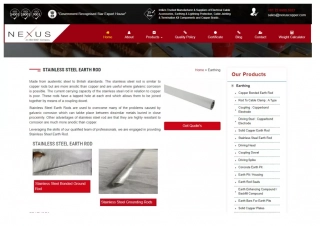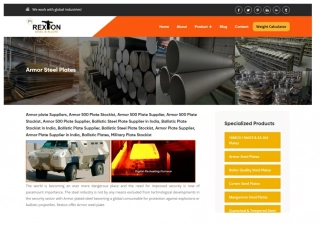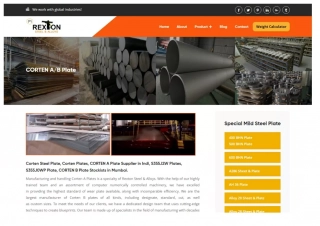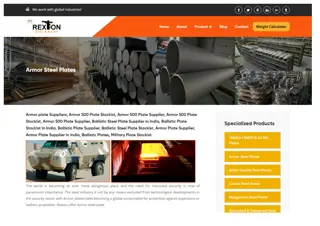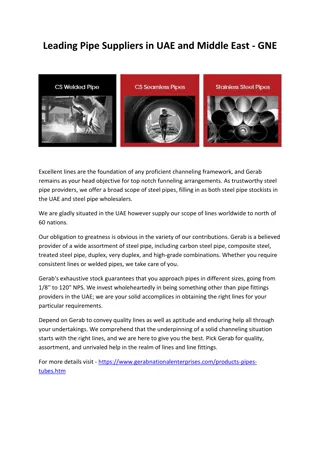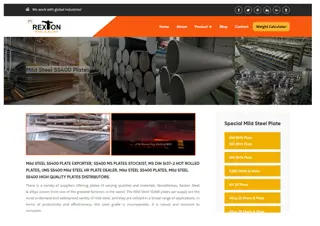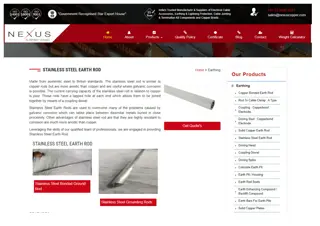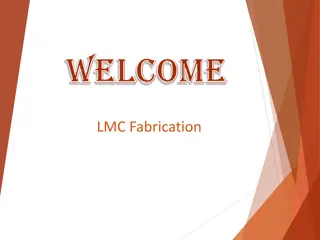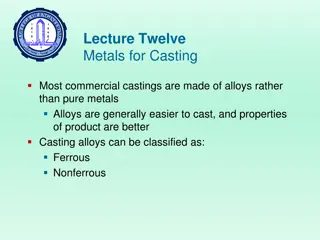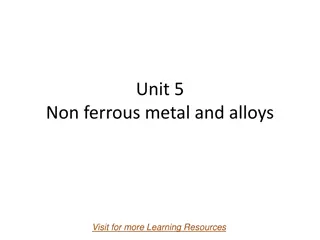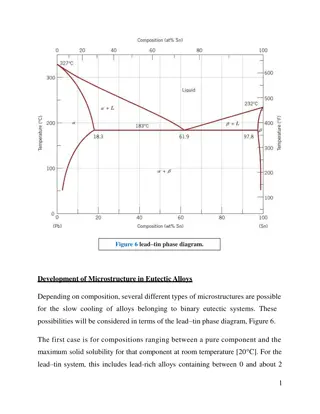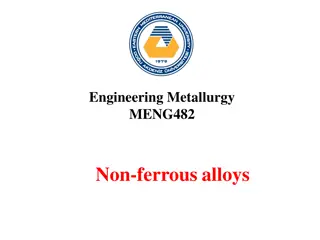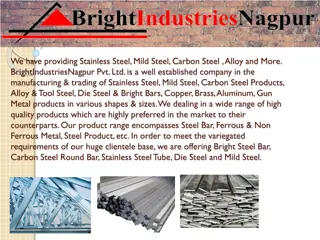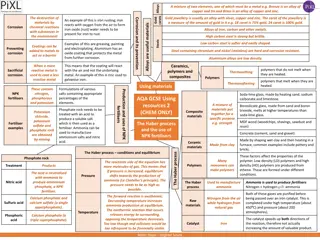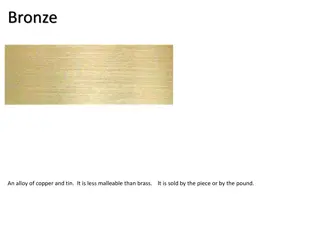Understanding Heat Treatment in Steel Alloys
Heat treatment is a crucial method to modify the physical and chemical properties of materials like steel. The amount of carbon in plain carbon steel determines the heat treatment required, influencing properties like hardness and machinability. Different types of heat treatment include annealing, normalizing, hardening, carburizing, and tempering, each serving specific purposes based on desired material properties. Stress-relief annealing, a sub-process, aims to reduce internal residual stresses without altering the material's structure or mechanical properties.
Download Presentation

Please find below an Image/Link to download the presentation.
The content on the website is provided AS IS for your information and personal use only. It may not be sold, licensed, or shared on other websites without obtaining consent from the author. Download presentation by click this link. If you encounter any issues during the download, it is possible that the publisher has removed the file from their server.
E N D
Presentation Transcript
The amount of carbon present in plain carbon steel has a pronounced effect on the properties of a steel and on the selection of suitable heat treatments to attain certain desired properties. Heat treatment is a method used to alter the physical, and sometimes chemical properties of a material. The most common application is metallurgical It involves the use of heating or chilling, normally to extreme temperatures, to achieve a desired result such as hardening or softening of a material It applies only to processes where the heating and cooling are done for the specific purpose of altering properties intentionally
Types Annealing Normalizing Hardening Carburizing Tempering
Annealing Steel is annealed to reduce the hardness, improve machine ability, facilitate cold-working, produce a desired microstructure. Full annealing is the process of softening steel by a heating and cooling cycle, so that it may be bent or cut easily. In annealing, steel is heated above the transformation temperature to form austenite, and cooled very slowly, usually in the furnace.
Types of Annealing 1. Stress-Relief Annealing (or Stress- relieving) 2. Normalizing 3. Isothermal Annealing 4. Spheroidizing Annealing (or Spheroidizing )
1. Stress-Relief Annealing It is an annealing process below the transformation temperature Ac1, with subsequent slow cooling, the aim of which is to reduce the internal residual stresses in a workpiece without intentionally changing its structure and mechanical properties
Causes of Residual Stresses 1. Thermal factors (e.g., thermal stresses caused by temperature gradients within the workpiece during heating or cooling) 2. Mechanical factors (e.g., cold-working) 3. Metallurgical factors (e.g., transformation of the microstructure)
Stress-Relief Annealing Process For plain carbon and low-alloy steels the temperature to which the specimen is heated is usually between 450 and 650 C, whereas for hot- working tool steels and high-speed steels it is between 600 and 750 C This treatment will not cause any phase changes, but recrystallization may take place. Machining allowance sufficient to compensate for any warping resulting from stress relieving should be provided
Normalizing In normalizing steel is also heated above austenitizing temperature, but cooling is accomplished by still air cooling in a furnace. Steel is normalized to refine grain size, make its structure more uniform, or to improve machinability. When steel is heated to a high temperature, the carbon can readily diffuse throughout, and the result is a reasonably uniform composition from one area to the next. The steel is then more homogeneous and will respond to the heat treatment in a more uniform way.
2. Normalizing A heat treatment process consisting of austenitizing at temperatures of 30 80 C above the AC3 transformation temperature followed by slow cooling (usually in air) The aim of which is to obtain a fine- grained, uniformly distributed, ferrite pearlite structure Normalizing is applied mainly to unalloyed and low-alloy hypoeutectoid steels For hypereutectoid steels the austenitizing temperature is 30 80 C above the AC1 or ACm transformation temperature
Normalizing The process might be more accurately described as a homogenizing or grain-refining treatment. Within any piece of steel, the composition is usually not uniform throughout. That is, one area may have more carbon than the area adjacent to it. These cornpositional differences affect the way in which the steel will respond to heat treatment. Because of characteristics inherent in cast steel, the normalizing treatment is more frequently applied to ingots prior to working, and to steel castings and forgings prior to hardening.
Normalizing Heating and Cooling
Hardening Hardening is carried out by quenching a steel, that is cooling it rapidly from a temperature above the transformation temperature. Steel is quenched in water or brine for the most rapid cooling, in oil for some alloy steels, and in air for certain higher alloy steels. With this fast cooling rate, the transformation from austenite to pearlite cannot occur and the new phase obtained by quenching is called marten site. Martensite is a supersaturated metastable phase and have body centered tetragonal lettice (bct) instead of bcc. After steel is quenched, it is usually very hard and strong but brittle. Martensite looks needle-like under microscope due to its fine lamellar structure.
Case Hardening Case Hardening is a process of hardening ferrous alloys so that the surface layer or case is made substantially harder than the interior or core. The chemical composition of the surface layer is altered during the treatment by the addition of carbon, nitrogen, or both. City Steel Heat Treating provides the most common processes of Carburizing, Carbonitriding, and Gas Nitriding
Carburizing Carburizing is a process used to harden low carbon steels that normally would not respond to quenching and tempering. This is done for economical reasons (utilizing less expensive steel) or design considerations to provide a tough part with good wear characteristics.
Carburizing Carburizing introduces carbon into a solid ferrous alloy by heating the metal in contact with a carbonaceous material to a temperature above the transformation range and holding at that temperature.
Tempering Tempering (formerly called drawing), consists of reheating a quenched steel to a suitable temperature below the transformation temperature for an appropriate time and cooling back to room temperature. Freshly quenched marten site is hard but not ductile. Tempering is needed to impart ductility to marten site usually at a small sacrifice in strength.
Tempering The effect of tempering may be illustrated as follows. If the head of a hammer were quenched to a fully martensitic structure, it probably would crack after the first few blows. Tempering during manufacture of the hammer imparts shock resistance with only a slight decrease in hardness. Tempering is accomplished by heating a quenched part to some point below the transformation temperature, and holding it at this temperature for an hour or more, depending on its size.
Tempering The micro structural changes accompanying tempering include loss of acicular marten site pattern and the precipitation of tiny carbide particles. This micro structural is referred to as tempered marten site.




